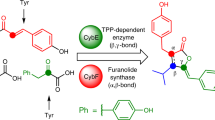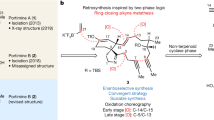Abstract
Brevetoxin A is the most potent neurotoxin secreted by Gymnodinium breve Davis, a marine organism often associated with harmful algal blooms known as ‘red tides’1,2,3. The compound, whose mechanism of action involves binding to and opening of sodium channels4,5,6,7, is sufficiently toxic to kill fish at concentrations of nanograms per ml (refs 3, 4) and, after accumulation in filter-feeding shellfish, to poison human consumers. The precise pathway by which nature constructs brevetoxin A is at present unknown8,9, but strategies for its total synthesis have been contemplated for some time. The synthetic challenge posed by brevetoxin A reflects the high complexity of its molecular structure: 10 oxygen atoms and a chain of 44 carbon atoms are woven into a polycyclic macromolecule that includes 10 rings (containing between 5 and 9 atoms) and 22 stereogenic centres. Particularly challenging are the 7-, 8- and 9-membered rings which allow the molecule to undergo slow conformational changes and force a 90° twist at one of its rings1,2,3,4,5,6. Here we describe the successful incorporation of methods that were specifically developed for the construction of these rings10,11 into an overall strategy for the total synthesis of brevetoxin A in its naturally occurring form. The convergent synthesis reported here renders this scarce neurotoxin synthetically available and, more importantly, allows the design and synthesis of analogues for further biochemical studies.
This is a preview of subscription content, access via your institution
Access options
Subscribe to this journal
Receive 51 print issues and online access
$199.00 per year
only $3.90 per issue
Buy this article
- Purchase on Springer Link
- Instant access to full article PDF
Prices may be subject to local taxes which are calculated during checkout






Similar content being viewed by others
References
Shimizu, Y., Chou, H.-N. & Bando, H. Structure of brevetoxin A (GB-1 toxin), the most potent toxin in the Florida red tide organism Gymnodinium breve (Ptychodiscus brevis). J. Am. Chem. Soc. 108, 514–515 (1986).
Shimizu, Y., Bando, H., Chou, H.-N., Van Duyne, G. & Clardy, J. C. Absolute configuration of brevetoxins. J. Chem. Soc., Chem. Commun. 1656–1658 (1986).
Pawlak, J.et al. Structure of brevetoxin A as constructed from NMR and MS data. J. Am. Chem. Soc. 109, 1144–1150 (1987).
Rein, K. S., Baden, D. G. & Gawley, R. E. Conformational analysis of the sodium channel modulator, brevetoxin A, comparison with brevetoxin B conformations, and a hypothesis about the common pharmacophore of the “site 5” toxins. J. Org. Chem. 59, 2101–2106 (1994).
Rein, K. S., Lynn, B., Baden, D. G. & Gawley, R. E. Brevetoxin B: chemical modifications, synaptosome binding, toxicity, and an unexpected conformational effect. J. Org. Chem. 59, 2107–21013 (1994).
Yasumoto, T. & Murata, M. Marine toxins. Chem. Rev. 93, 1897–1909 (1993).
Gawley, R. E.et al. The relationship of brevetoxin “length” and A-ring functionality to binding and activity in neuronal sodium channels. Chem. Biol. 2, 533–541 (1995).
Chou, H.-N. & Shimizu, Y. Biosynthesis of brevetoxins. Evidence for the mixed origin of the backbone carbon chain and the possible involvement of dicarboxylic acids. J. Am. Chem. Soc. 109, 2184–2185 (1987).
Lee, M. S., Qin, G.-W., Nakanishi, K. & Zagorski, M. G. Biosynthesis studies on brevetoxins, potent neurotoxins produced by the dinoflagellate Gymnodinium breve. J. Am. Chem. Soc. 111, 6234–6241 (1989).
Nicolaou, K. C., Prasad, C. V. C., Hwang, C.-K., Duggan, M. E. & Veale, C. A. Cyclizations of hydroxydithioketals. New synthetic technology for the construction of oxocenes and related medium ring systems. J. Am. Chem. Soc. 111, 5321–5330 (1989).
Nicolaou, K. C., Shi, G.-Q., Gunzner, J. L., Gärtner, P. & Yang, Z. Palladium-catalyzed functionalization of lactones via their cyclic ketene acetal phosphates. Efficient new synthetic technology for the construction of medium and large cyclic ethers. J. Am. Chem. Soc. 119, 5467–5468 (1997).
Nicolaou, K. C., Prasad, C. V. C., Somers, P. K. & Hwang, C.-K. Activation of 6-endo over 5-exo hydroxy epoxide openings. Stereo- and ringselective synthesis of tetrahydrofuran and tetrahydropyran systems. J. Am. Chem. Soc. 111, 5330–5334 (1989).
Freeman, J. P. in Organic Syntheses (Collective Vol. VII) 139–141 (Wiley, New York, 1990).
Xie, M., Beges, D. A. & Robins, M. J. Efficient “dehomologation” of di-O-isopropylidenehexofuranose derivatives to give O-isopropylidenepentofuranose by sequential treatment with periodic acid in ethyl acetate and sodium borohydride. J. Org. Chem. 61, 5178–5179 (1996).
Mukaiyama, T., Banno, K. & Narasaka, K. New cross-aldol reactions. Reactions of silyl enol ethers with carbonyl compounds activated by titanium tetrachloride. J. Am. Chem. Soc. 96, 7503–7509 (1974).
Rodeheaver, G. T. & Hunt, D. F. Conversion of olefins into ketones with mercuric acetate and palladium chloride. Chem. Commun. 818–819 (1971).
Tamura, Y., Ochiai, H., Nakamura, T. & Yoshida, Z. Arylation and vinylation of 2-carboethoxyethylzinc iodide and 3-carboethoxypropylzinc iodide catalyzed by palladium. Tetrahedr. Lett. 27, 955–958 (1986).
Inanaga, J., Hirata, K., Saeki, H., Katsuki, T. & Yamaguchi, M. Arapid esterification by mixed anhydride and its application to large-ring lactonization. Bull. Chem. Soc. Jpn 52, 1989–1993 (1979).
Arhart, R. J. & Martin, J. C. Sulfuranes, V. The chemistry of sulfur (IV) compounds. Dialkoxydiarylsulfuranes. J. Am. Chem. Soc. 94, 4997–5003 (1972).
Hoveyda, A. H., Evans, D. A. & Fu, G. C. Substrate-directable chemical reactions. Chem. Rev. 93, 1307–1370 (1993).
Nicolaou, K. C., McGarry, D. G. & Sommers, P. K. New synthetic strategies for the construction of medium-size cyclic ethers. Stereocontrolled synthesis of the BCD ring framework of brevetoxin A. J.Am. Chem. Soc. 112, 3696–3697 (1990).
Corey, E. J. & Beames, D. J. Mixed cuprate reagents of type R1R2CuLi which allow selective group transfer. J. Am. Chem. Soc. 94, 7210–7211 (1972).
Ley, S. V., Norman, J., Griffith, W. P. & Marsden, S. P. Tetrapropylammonium perruthenate, Pr4N+RuO4−, TPAP: a catalytic oxidant for organic synthesis. Synthesis 639–666 (1994).
Nicolaou, K. C.et al. New synthetic technology for the construction of 9-membered ring cyclic ethers. Construction of the EFGH ring skeleton of brevetoxin A. J. Am. Chem. Soc. 119, 8105–8106 (1997).
Mahoney, W. S., Brestensky, D. M. & Stryker, J. M. Selective hydride-mediated conjugate reduction of α, β-unsaturated carbonyl compounds using [(Ph3P)CuH]6. J. Am. Chem. Soc. 119, 8105–8106 (1997).
Feixas, J., Capdevila, A. & Guerrero, A. Utilization of neutral alumina as a mild reagent for the selective cleavage of primary and secondary silyl ethers. Tetrahedron 50, 8539–8550 (1994).
Nicolaou, K. C.et al. Novel strategies for the construction of complex polycyclic ether frameworks. Stereocontrolled synthesis of the FGHIJ ring system of brevetoxin A. Angew. Chem. Int. Edn. Engl. 30, 299–303 (1991).
Parikh, J. R. & Doering, W. vonE. Sulfur trioxide in the oxidation of alcohols by dimethyl sulfoxide. J.Am. Chem. Soc. 89, 5505–5507 (1967).
Clayden, J. & Warren, S. Stereocontrol in organic synthesis using the diphenylphosphoryl group. Angew. Chem. Int. Edn. Engl. 35, 241–270 (1996).
Zagorski, M. G., Nakanishi, K., Qin, G.-W. & Lee, M. S. Assignment of 13C NMR peaks of brevetoxin A: application of two-dimensional Hartmann-Hahn spectroscopy. J. Org. Chem. 53, 4156–4157 (1988).
Lee, M. S., Nakanishi, K. & Zagorski, M. G. Full proton assignment of BTX-A, C49H70O13. New J.Chem. 11, 753–756 (1987).
Klindgren, B. O. & Nilsson, T. Preparation of carboxylic acids from aldehydes (including hydroxylated benzaldehydes) by oxidation with chlorite. Acta Chem. Scand. 27, 888–890 (1973).
Dess, D. B. & Martin, J. C. Readily accessible 12-I-5 oxidant for the conversion of primary and secondary alcohols to aldehydes and ketones. J. Org. Chem. 48, 4155–4156 (1983).
Schreiber, J., Maag, H., Hashimoto, N. & Eschenmoser, A. Dimethyl(methylene)ammonium iodide. Angew. Chem. Int. Edn. Engl. 10, 330–331 (1971).
Nicolaou, K. C.et al. Total synthesis of brevetoxin B. 1. First generation strategies and new approaches to oxepane systems. J. Am. Chem. Soc. 117, 10227–10238 (1995).
Nicolaou, K. C.et al. Total synthesis of brevetoxin B. 2. Second generation strategies and construction of the dioxepane region [DEFG]. J. Am. Chem. Soc. 117, 10239–10251 (1995).
Nicolaou, K. C.et al. Total synthesis of brevetoxin B. 3. Final strategy and completion. J. Am. Chem. Soc. 117, 10252–10263 (1995).
Nicolaou, K. C. The total synthesis of brevetoxin B: a twelve year odyssey in organic synthesis. Angew. Chem. Int. Edn. Engl. 35, 589–607 (1996).
Homaka, Y. Recent methods for detection of seafood toxins: recent immunological method for ciguatoxin and related polyethers. Food Addit. Contam. 10, 71–82 (1993).
Anderson, D. M. Turning back the harmful red tide. Nature 388, 513–514 (1997).
Barker, R. And the Waters Turned to Blood (Simon & Schuster, New York, 1997).
Anderson, D. M. Red tides. Sci. Am. 271, 62–68 (1994).
Hall, S. & Strichartz, G. (eds) (American Chemical Society, Washington DC, 1990).
Okaichi, T., Anderson, D. M. & Nemoto, T. (eds) Red Tides. Biology, Environmental Science, and Toxicology (Elsevier, New York, 1989).
Anderson, D. M. & White, A. W. Marine biotoxins at the top of the food chain. Oceanus 35, 55–61 (1992).
Acknowledgements
We are indebeted to those of our collaborators whose early contributions on this project made its success possible; their names will appear in the full account of this work. We thank K.Nakanishi and Y. Shimizu for samples of natural brevetoxin A, and D. H. Huang, G. Siuzdak and R.Chadha for the NMR, mass spectroscopic and X-ray crystallographic assistance, respectively. This work was supported by the National Institutes of Health USA (GM), The Skaggs Institute for Chemical Biology, Novartis, Merck, Hoffmann-La Roche, Schering Plough, DuPont Merck, the American Chemical Society (graduate fellowship sponsored by Aldrich to J.L.G.) and the Foundation for the Promotion of Scientific Investigations (postdoctoral fellowship to P.G.). Z.Y. and G.S. contributed equally to this project.
Author information
Authors and Affiliations
Corresponding author
Supplementary Information
Rights and permissions
About this article
Cite this article
Nicolaou, K., Yang, Z., Shi, Gq. et al. Total synthesis of brevetoxin A. Nature 392, 264–269 (1998). https://doi.org/10.1038/32623
Received:
Accepted:
Issue Date:
DOI: https://doi.org/10.1038/32623
This article is cited by
-
Unexplored territory for self-assembly
Nature (2016)
-
Racemic and enantioselective total synthesis of heliespirones A & C
Science China Chemistry (2011)
-
Zippier synthesis in water
Nature (2007)
Comments
By submitting a comment you agree to abide by our Terms and Community Guidelines. If you find something abusive or that does not comply with our terms or guidelines please flag it as inappropriate.



